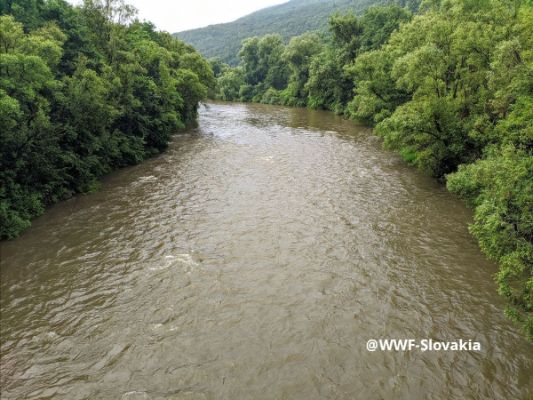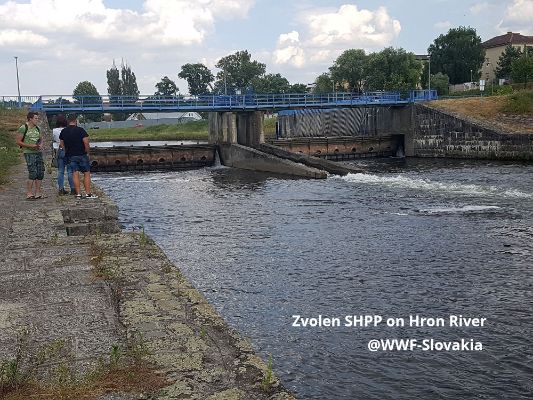Landmark Slovak Court Decision On Small Hydropower
Court Decision in Small Hydropower Case: The Public Interest Takes Precedent over Private Business

The Supreme Court of the Slovak Republic definitively stopped the licensing of a small hydroelectric power plant in Žiar nad Hronom, Central Slovakia. In the landmark decision, the Slovakian Supreme Court said, “The public interest, which is the protection of the environment, takes precedence over private business interest.”
2020 July 30 - The Supreme Court of the Slovak Republic upheld the decision of the Banská Bystrica Regional Court which, due to illegality, cancelled the decision of the Žiar nad Hronom building authority which allowed the siting of a small hydroelectric power plant in Žiar nad Hronom on the Hron River. It is another in a series of legal disputes over the controversial construction of small hydropower plants (SHPP) on the Hron. There are 22 additional SHPPs planned on the river, in addition to the 20 already in operation.
Conservation organisations (Association Slatinka, Rieka, Hereditas HH and the Slovak Fishermen's Association) with the support of WWF-Slovakia legally challenged the siting decision in 2018 by filing a lawsuit in cooperation with the VIA IURIS association.

The Regional Court in Banska Bystrica ruled on the matter in the autumn of 2018. The Court accepted some of the plaintiffs' arguments and annulled the decision to locate the SHPP. However, the investor and also the District Office in Banská Bystrica appealed against this judgment. The Supreme Court’s final decision this week fully upheld the judgment of the Banská Bystrica Regional Court. In its arguments, the Supreme Court added extensive and thorough considerations with clear instructions applicable to other cases.
“ASHPP in Žiar nad Hronom would have been another obstacle on the Hron River. There are already two SHPP (Hronská Dúbrava and Zvolen) on that 25 km stretch of river. Both are impassable for migratory fish. According to the Supreme Court, there was no proper assessment of the environmental effects of the construction. Furthermore, the Žiar nad Hronom Building Authority did not pay sufficient attention to the public interest - the protection of the environment. It is a ground-breaking decision, because for the first time the Supreme Court paid close attention to the fact that building authorities must also take their role seriously to protect the environment in territorial proceedings,” said Miroslava Plassmann, CEO of WWF-Slovakia.
The Supreme Court’s ruling cannot be appealed. Following this decision, WWF-Slovakia also calls on the competent state authorities to start considering the removal of existing small hydropower plants, especially those whose negative effects significantly outweigh the positive ones. The recent Pan-European Atlas of In-Stream Barriers identified 152 dams, wiers, sluices and other barriers on 20412 km of Slovakian rivers.
The most important points of the decision:
The court decision is extensive and detailed. The most important frameworks applicable to other environmental cases include:
- Assessment of the conflict of public-private interest in the authorisation of SHPPs. The public interest in protecting the environment takes precedence over the private interest in the potential production of electricity from a small hydropower plant. The Supreme Court literally stated that “in the case of siting SHPP on a ‘living organism’ in nature, such as on the Hron River, the public interest is mainly the protection of the environment, individual animal species and habitats in this area.” The Supreme Court pointed out that it was the duty of the administrative authorities to examine whether the construction of an SHPP is in accordance with environmental protection and the public interest, and this examination must not be formalistic.
- Strategic document as a general argument for siting SHPPs. In the opinion of the Supreme Court, the administrative authorities cannot refer generally to the existence of an approved strategic environmental assessment (in Slovakia it is the Updated Concept of Utilising Hydro-energetic Potential of Watercourses by 2030) as the basis for a decision. Even if a specific SHPP is mentioned, the permitting authority must assess whether “the benefit of the generation of electricity from the SHPP has been evaluated against the intervention caused by its construction and operation, and the future impact on the environment (including irreversible and irreparable damage) taking into consideration the value of electricity produced by SHPP and State (European) subsidies and the findings of the ‘net’ economic impact, efficiency, construction and operation of the SHPP.”
- Environmental impact assessment (EIA) of the proposed construction if legal regulation has been tightened since the original the assessment process. Output from an EIA process is mandatory for further stages of the building permit procedure in Slovakia. In this case, the decision taken on February 3, 2016 was in harmony with legislation in force at that time, and the impact assessment of SHPP Žiar nad Hronom did not have to go through a full EIA process. However, there was a legislative change in January 2017. Since then, these types of structures must undergo a full EIA procedure. The Supreme Court expressed the opinion that the evaluation procedure was not carried out sufficiently or correctly. Additionally, if legal regulation has been tightened since the original the assessment process, the administrative bodies must consider and justify any significant changes which have taken place in the area concerned; including any newly emerging facts, new technologies and procedures which would result in the need to initiate a new, updated EIA procedure. Naturally, the cumulative impact of already existing SHPPs on the river must also be assessed. This cannot be negated by the application of the principles of legal certainty (legitimate expectation of SHPP investor) and the assumption that the conduct of the administrative authorities and courts were in accordance with past and effective legislation was lawful.
- A spatial plan as the basis for siting SHPPs. The Court has also analysed the issue of SHPP siting when there is a contradiction between local and regional spatial plans (a regional plan takes precedence over a local plan). In this case, the Regional Spatial Plan protects the Hron River while the Local Spatial Plan of the Žiar nad Hronom municipality allows the siting of an SHPP. In the opinion of the Supreme Court, the local spatial plan should not be applied in such a case.
- Linear structure and SHPP. Linear structures undergo a simplified authorisation process in Slovakia and for this reason some investors purposefully claim that SHPPs are linear structures. The Supreme Court has said that the responsible administrative body must examine and justify why it considers the given construction to be linear. If parties to the proceedings, e.g. environmental organisations disagree, the issue must be referred for decision to a specialised building authority.
Background:
With 1000 hydropower plants, 400 more are planned or under construction, Bulgaria, Hungary, Slovakia, Romania and Ukraine are already saturated. The Danube catchment is becoming one of the most affected large river catchments not only in Europe but also worldwide. The Danube’s flow is being impeded by the Iron Gates Dams at river kilometre 863, hindering highly threatened migratory sturgeons and other fish from entering important spawning and feeding sites in the Middle Danube. The Olt River, originating in the Carpathian Mountains, is covered by a long chain of hydropower plants. Numerous new projects are appearing. They include plans for two large dams on the Lower Danube, which date as far back as the Soviet rule, and many new small hydropower projects in Ukraine. However, the environmental opposition against new dams is high. Some of the projects on larger rivers might be suspended such as those on the lower Drava, where the recently designated 5-country Mura-Drava-Danube Biosphere Reserve managed to change the narrative. 2,500 (28%) of all planned hydropower is in protected areas (33% in the EU); such as two hydropower projects threatening Natura 2000 sites in Romania: one in Defileul Jiului National Park and the other in Răstolia where the government recently modified legislation to open up dam construction in all protected areas across the country.
There is still an opportunity to turn the tide.The hundreds of hydropower, and dozens of navigation and flood protection infrastructure plans under preparation in Central and Eastern Europe would require proper biodiversity safeguards or be dropped altogether under the EU Water Framework Directive (WFD) in order to ensure that no harm will be done to migratory fish and their habitats.
WWF-CEE is addressing threats to rivers and wetlands, including dangers posed by inappropriate dams and other infrastructure; promoting guidelines and best practices for the development of hydropower to provide security of planning for investors; and ensuring that clean and renewable energy from water does not come at too great a price in terms of other ecosystem goods and services. For example, advocacy by WWF-Romania and its partners prevented EU funds from financing harmful flood infrastructure projects at Colibita and Gurasada. In a case initiated by WWF, Romania’s highest court ordered a stop to construction of a dam on the Jiu River. In Ukraine, construction of a planned cascade of six hydro plants on the Dniester River has been frozen. The Drava River Campaign with WWF-Adria placed 2 hydropower plants along the Drava on indefinite hold.


 ICHRP: ICHRP Condemns Harassment And Threats Against Victims Of Duterte’s War On The Poor
ICHRP: ICHRP Condemns Harassment And Threats Against Victims Of Duterte’s War On The Poor World Vision: 3.5 Million Displaced Following Myanmar Earthquake And Ongoing Internal Conflict
World Vision: 3.5 Million Displaced Following Myanmar Earthquake And Ongoing Internal Conflict World Butchers Challenge: World’s Top Butchers From 14 Nations Go Knife-to-Knife In Paris
World Butchers Challenge: World’s Top Butchers From 14 Nations Go Knife-to-Knife In Paris Save The Children: ‘It Was Terrifying’ - Children Prepare To Spend Myanmar New Year Festival In Shelters Following Earthquake
Save The Children: ‘It Was Terrifying’ - Children Prepare To Spend Myanmar New Year Festival In Shelters Following Earthquake Global Forest Coalition: Global NGOs Call On International Maritime Org To Reject Biofuels And Commit To Truly Clean Energy
Global Forest Coalition: Global NGOs Call On International Maritime Org To Reject Biofuels And Commit To Truly Clean Energy Australian Catholic University: Principals Navigate Growing Challenges As Anxiety, Depression Increase And Violence, Workloads Intensify
Australian Catholic University: Principals Navigate Growing Challenges As Anxiety, Depression Increase And Violence, Workloads Intensify